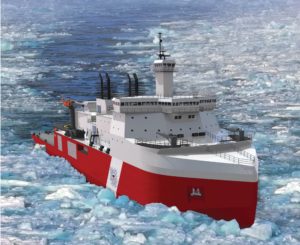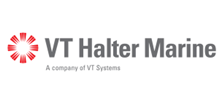VT Halter Marine, Inc., is using R3’s Integrated Contract and Program Management Software to Manage the Design and Build of “First of Class” Ship for the U.S. Coast Guard.
Design and construction of any ship is a complex process that involves dozens of organizations, hundreds—even thousands—of people, and many documents, drawings, schedules, and plans. Collaboration and information sharing among the organizations and people is critical to the success of the project. But when that project is a “first of class” ship, the stakes are higher, the demands greater, and the need for communication and collaboration takes on even greater significance.
VT Halter Marine, Inc., a company of Vision Technology Systems, is a leader in the design and construction of medium-sized ships in both the commercial and defense sectors. For more than 70 years, it has designed, built, and repaired a wide variety of ocean-going vessels, including patrol vessels, ferries, cargo vessels, and research vessels.
In 2019, Halter was awarded the prime contract to build the first-ever Polar Security Cutter for the U.S. Coast Guard (USCG). This “first of class” ship will support the USCG mission in the polar regions, which are vital to the economic vitality, scientific inquiry, and national interests of the United States.
The Challenge
The Coast Guard contract required VT Halter to provide a system that would enable them to have real-time access to information during the shipbuilding process. It would need to be an integrated data environment (IDE) combining data on contract deliverables and documents. It also would need to support real-time, secure collaboration between Halter, the Coast Guard, Subcontractors, Regulatory Agencies, and suppliers.
Halter knew there would be many thousands of contractual process deliverables that would need to be tracked and reported on. First of Class ships have a greater scope of managed deliverables because they involve a great deal of engineering and design work, as well as build work. Each deliverable would have multiple documents and drawings that needed to be shared with the Coast Guard and all the subcontractors and suppliers. It also knew that the documents and drawings could potentially be huge files and have some level of security requirements. So, typical collaboration tools like email and file shares weren’t going to work.
Historically, for other projects, they would track contract deliverables in a spreadsheet or database. They would store documents in a file share or SharePoint. And, they would use an ftp site to distribute documents. They knew this approach would not be sufficient to meet the contractual needs of the parties and the demands of the project. The customer and each subcontractor would need their own ftp site, and with 29 unique subcontractors, it would be inefficient and time consuming to use the ftp. Plus, data wasn’t available over time, and Halter would have to post the same data over and over, so it was accessible to the subcontractors and customer.
Further, each document related to a contract deliverable. So, they would have to do updates of the deliverable tracking system based on the status of the documents. This is a lot of work. It was not real time. And, it made it very possible that things would fall through the cracks.
They considered other COTS systems such as Siemens Teamcenter a Product Lifecycle Management System. However, these systems are designed to tie all work back to product parts as opposed to contract/process deliverables, which require greater flexibility in the type of hierarchical structure of contract deliverables.
The Solution
In search for an IDE that would support real-time collaboration, Halter selected R3’s integrated Contract and Program Management Software for Federal Government Contractors. This COTS system is designed specifically to meet the demands of federal programs. The software gave Halter a fast, easy, and affordable way to enable collaboration among all the parties in a secure IDE that brings the deliverable data together with the documents. The software was flexible enough to meet the unique requirements of the project and not force Halter to modify the way they worked. Plus, it was very affordable compared to several of the other systems that are typically used for these complex ship-building projects.
After a short implementation period involving configuration changes to the COTS system, Halter rolled out the R3 system and met the contractual requirements of the Coast Guard within the contracted time frame.
“When we launched the R3 system, we got some major pushback,” said John Lawrence, Document Control Manager at Halter. “People were used to using an ftp site for documents. Getting people to adopt the new system wasn’t easy. But people quickly began seeing the value and ease of use of the R3 system. Now we have 130 users from the Coast Guard on the system, and hundreds of people from all 29 subcontractors, not to mention all of our suppliers.”
According to Lawrence, the system is “very collaborative” and greatly facilitates the sharing of information, primarily documents. Parties can post documents and all users can see what’s been posted, when it was posted, and if it’s been reviewed and approved. The documents are all related to specific contractual process deliverables based on their project hierarchy. This enables them to track and manage and report on the status of each contract deliverable in real time.
One of the key features is R3’s-controlled access. With an ftp site, to ensure users only saw what they were supposed to see, you had to post things to specific sites. The R3 system is role-based. You just put people into roles or groups, such as each subcontractor. The system then controls what the person can see and what they can do. Roles and members can be controlled down to each contract deliverable action item. This means Halter only must post the document once, as opposed to posting it to 29 different ftp sites for each subcontractor. This is a tremendous time saver and provides the type of security and permissions control Halter needed.
“When something is ready, we release it to the Coast Guard through the system,” said Lawrence. “And we use the access controls to say who can see it. Before, we would have to post it to 29 different ftp sites for each subcontractor, plus the customer. So, the access control is critical for us.”
In addition to the time savings, the system simplifies the sharing and movement of huge files. Design documents, CAD drawings, and other documents required in the ship-building process can’t be shared via email because of their size. Plus, most of them are categorized as “controlled, unclassified,” which means they can’t be emailed anyway. So, the system gives Halter greater control and manageability with such documents.
Lawrence cited the flexibility of the system as another key benefit. This was critical for them to be able to set it up to meet the project hierarchy for their Master Schedule, Contract Deliverables, and Action Items. He said Halter has been “creative” with the system and is using it in additional ways. They have libraries for industry standards. And, they can create working groups to collaborate for specific purposes.
“You can organize and store your data any way you want to store it,” said Lawrence. “You don’t get that with a lot of other systems, especially systems designed for these types of projects. Those systems force you to store and manage your data a specific way such as tied to product parts. They don’t offer the same flexibility.”
Moving forward, Halter is looking to use the R3 system on new and other existing shipbuilding programs.
“I’m not sure how we would do all of this without the R3 solution,” said Lawrence. “It’s definitely been our lifesaver.”
Industry
Government Contracting - Ship Building
Type of Business
Large
R3 Solutions
R3 Program Management and R3 Contract Management
“I’m not sure how we would do all of this without the R3 solution,” said John Lawrence, Document Control Manager at VT Halter. “It’s definitely been our lifesaver.”
“You can organize and store your data any way you want to store it,” said Lawrence. “You don’t get that with a lot of other systems, especially systems designed for these types of projects. Those systems force you to store and manage your data a specific way such as tied to product parts. They don’t offer the same flexibility.”
“When we launched the R3 system, we got some major pushback,” said Lawrence. “People were used to using an ftp site for documents. Getting people to adopt the new system wasn’t easy. But people quickly began seeing the value and ease of use of the R3 system. Now we have 130 users from the Coast Guard on the system, and hundreds of people from all 29 subcontractors, not to mention all of our suppliers.”
“When something is ready, we release it to the Coast Guard through the system,” said Lawrence. “And we use the access controls to say who can see it. Before, we would have to post it to 29 different ftp sites for each subcontractor, plus the customer. So, the access control is critical for us.”


